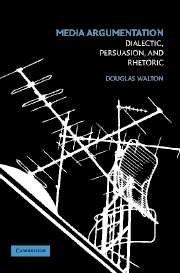Book contents
- Frontmatter
- Contents
- Acknowledgments
- Introduction
- 1 Logic, Dialectic, and Rhetoric
- 2 The Speech Act of Persuasion
- 3 Propaganda
- 4 Appeals to Fear and Pity
- 5 Ad Hominem Arguments in Political Discourse
- 6 Arguments Based on Popular Opinion
- 7 Fallacies and Bias in Public Opinion Polling
- 8 Persuasive Definitions and Public Policy Arguments
- 9 The Structure of Media Argumentation
- Bibliography
- Index
- Plate section
9 - The Structure of Media Argumentation
Published online by Cambridge University Press: 05 June 2012
- Frontmatter
- Contents
- Acknowledgments
- Introduction
- 1 Logic, Dialectic, and Rhetoric
- 2 The Speech Act of Persuasion
- 3 Propaganda
- 4 Appeals to Fear and Pity
- 5 Ad Hominem Arguments in Political Discourse
- 6 Arguments Based on Popular Opinion
- 7 Fallacies and Bias in Public Opinion Polling
- 8 Persuasive Definitions and Public Policy Arguments
- 9 The Structure of Media Argumentation
- Bibliography
- Index
- Plate section
Summary
The cases studied in the previous chapters have suggested how dialectical and rhetorical methods need to be combined to reveal tactical argument moves and strategies underlying media argumentation. But the respondent-to-dialogue problem posed in chapter 4 remains unsolved. In this chapter, a solution to the problem is presented, using some technology from AI. We begin by reviewing the RTD problem and other unsolved problems brought out in the preceding chapters. These problems continue to be exacerbated by the troubled relationship between rhetoric and dialectic, and one problem is how to integrate the methods of each approach with the other. There is an inevitable tension between them, but paradoxically, one is not much good without the other when it comes to grasping how mass media argumentation works and getting better insights into both the strengths and weaknesses of this important type of argumentation. Solutions to these problems are proposed by putting forward several hypotheses that form a theory of how a proponent attempts to persuade an audience using argumentation across media.
The main elements of the theory are the following propositions. Both the audience and the arguer need to be seen as agents that share common knowledge that enables them to communicate. But some cases are more dialectically complex. In these cases, three agents are involved. Two basic types of media argumentation are distinguished. In direct media argumentation, only the proponent and the audience have the roles of agents.
- Type
- Chapter
- Information
- Media ArgumentationDialectic, Persuasion and Rhetoric, pp. 323 - 360Publisher: Cambridge University PressPrint publication year: 2007



